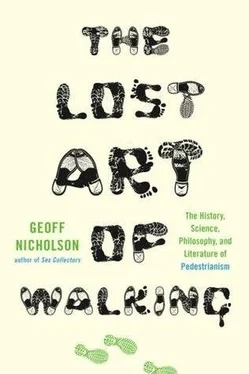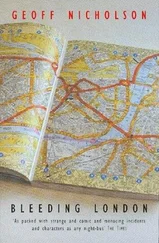Two of the younger, fitter men — William Manly and John Rogers — decided they would simply walk out of the valley on foot, cross the Panamint Range, get help, and return to rescue the survivors, if any. This, incredibly, they did, although Manley confessed in print that it had crossed his mind never to return for the others.
In any case, Manly and Rogers did the right thing. They walked 250 miles from Death Valley to the San Fernando Valley, where they obtained supplies, along with two horses and a mule. They were intending to ride at least part of the way back, but both horses died en route, so it turned into another walking expedition. Once they’d saved the people left behind, they all had to walk the route once again.
Manly eventually wrote his account of events in a book titled Death Valley in ‘49 . It is the story of his life as well as the story of the 49 ers, and parts of it read like a primer on the pains of walking and adverse walking conditions. He writes:
‘Walking began to get pretty tiresome. Great blisters would come on our feet, and, tender as they were, it was a great relief to take off our boots and go barefoot for a while when the ground was favorable’.
‘This valley was very sandy and hard to walk over’.
‘All the way had been hill and very tiresome walking’.
‘At times we walked in the bed of the stream in order to make more headway, but my lameness increased and we had to go very slow indeed.’
Manly’s book makes very little mention of God, or the Almighty’s role in his enforced walking, though he does describe the desert as the ‘most God-forsaken country in the world’. He’s extremely skeptical about ‘God’s purpose’ in imposing the ordeal on him, although others on the expedition take a more high-minded view.
Undoubtedly, walking may be used as a form of divine punishment, as variations on the story of the Wandering Jew indicate. Although he was supposedly present at the crucifixion, the Wandering Jew does not appear in the Bible, and seems to have been an invention of the thirteenth century, though refined and made more widely significant in the seventeenth century thanks to a series of pamphlets published in Germany from 1602 onward.
He goes by many names — Buttadeus, Ahaseurus, and Isaac Lacquedem among them — and is variously a shoemaker or Pontius Pilate’s doorman. What is central to the myth is his mocking of Christ. He sees Jesus carrying the cross and taunts him for walking too slowly. Jesus certainly received worse insults, but on this occasion he did not turn the other cheek. He condemned the Jew to walk the earth until the time of the Second Coming.
There is some resemblance here to Cain, the fratricide, to whom God says, ‘A fugitive and a vagabond shalt thou be in the earth’. This isn’t quite the same as condemning him to ‘walk the earth’, but a fugitive and a vagabond no doubt ends up doing a good amount of walking.
There’s also a resemblance to Jules Winnfield, played by Samuel L. Jackson in Quentin Tarantino’s Pulp Fiction , who says:
‘Basically, I’m just gonna walk the earth. You know, like Caine in Kung Fu — walk from place to place, meet people, get in adventures.’
It must have been such a delight for Tarantino when he was writing the script to invoke the biblical Cain and then immediately ditch him in favor of David Carradine’s TV character.
An Armenian bishop visiting England in 1228 not only asserted that the Wandering Jew was alive and walking, but that he’d met him. This was good news for Christians. To have someone around who had been an eyewitness at the crucifixion proved the historical basis of Christianity. It was also a myth that had its uses for Jews. The Wandering Jew dramatized and personified the diaspora, while also emphasizing the anti-Semitism and downright vindictiveness of certain Christians.
It is also an extremely rich and inventive myth of punishment. The sinner is punished not only by enforced walking but by joyless immortality. He must walk forever but he isn’t going anywhere. There’s no destination, no journey’s end. He is walking with no purpose, just killing time. He must exist in a state of constant fatigue, never experiencing rest, nor even the possibility of rest. He approaches an exhaustion that will never arrive, because if it did, then he would stop walking, and the divine power will not allow that.
Following the sighting by the thirteenth-century bishop, the Wandering Jew was spotted all over Europe throughout the seventeenth and eighteenth centuries, and at least once in the nineteenth century in the United States. According to Alex Bein in The Jewish Question: Biography of a World Problem , the ‘ Desert News reported on Sept. 23, 1868, that he had visited a Mormon named O’Grady’. How and why the Wandering Jew traveled to the United States must remain a question for speculation, but if he came by boat he must surely have spent the entire voyage walking around the deck. Perhaps he is walking still.
An Italian folktale, known as ‘Malchus at the Column’, is a variant on the story of the Wandering Jew, and devises an even worse and more inventive punishment. Malchus, by this legend, was one of the Jews responsible for the crucifixion of Jesus, and although all the others were forgiven, Malchus remained unforgivable because he’d physically struck the Virgin Mary. Consequently, he was confined inside a mountain, and forced to walk endlessly around a column until the end of the world.
As the story ‘opens’ Malchus has been walking in circles for so long that his footsteps have dug a deep circular trench in the earth and only his head appears above ground. When the path is trodden lower still and his head finally disappears, the world will come to an end and he will be sent to a place that God has prepared for him. I can’t decide whether this would be an incentive to walk more quickly or more slowly.
These stories seem to involve a myth more ancient than Christianity, more the stuff of Sisyphus or Tantalus, but the notion of a punishment without limit or motion, without hope of rest, is truly horrifying. We do want our walking to take us somehere: we want it to have an end.
♦
Non-Christian gods and non-Christian believers can also be passionately concerned with walking. Taoism, for example, employs various walking meditations that function as exercise, as spiritual practice, and ultimately as martial arts. The best known is Baguazhang, which is based on the I Ching and essentially involves walking in circles, sometimes known as ‘Turning the Circle’. The technique is four thousand years old and is based on the Taoist principle of seeking stillness in motion. It’s a way of walking that doesn’t in the practical sense take you anywhere, although as a martial art it does enable the initiate to walk in such a way that he can defend himself against attackers coming at him from eight different directions.
It was a Taoist, a Chinese woman named Guo Lin, who, in the middle of the twentieth century, developed a series of spiritual exercises known as Walking Qigong or Guolin Qigong. Qigong is the ancient Chinese art of balancing and strengthening the ‘life force’. Walking was her version of it, and she used it as a cure for cancer.
Guo Lin had had several bouts of cancer over more than a decade, along with the operations to ‘cure’ her, but finally in 1964 doctors declared that the cancer had won, and Guo Lin was given six months to live. Being full of fight and perhaps thinking she had nothing to lose, by relying on instinct and trial and error, and consulting some texts that had been left to her by her grandfather, a Taoist monk, she developed a method that worked for her. There were bending and stretching exercises, the control of breathing, the massaging of acupressure points, but the cornerstone was walking for two hours per day. At the end of her allotted six months the cancer had gone.
Читать дальше












